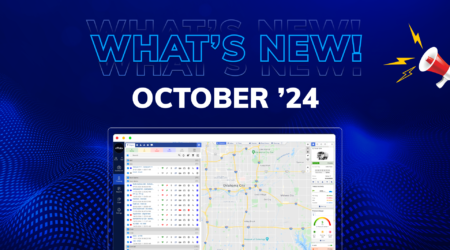Enhancing Safety and Compliance with Fleet Dispatching Software
In the fast-paced world of logistics, maintaining safety and compliance while optimizing efficiency is a challenging task. The advent of advanced fleet dispatching software has revolutionized this sector, providing tools that enhance operational safety and ensure regulatory compliance. In this comprehensive blog, we will explore how fleet dispatching software can transform fleet management, focusing on safety and compliance.
Introduction to Fleet Dispatching Software
Fleet dispatching software is a sophisticated tool designed to streamline the management of a fleet of vehicles. It provides real-time tracking, automated dispatching, route optimization, and comprehensive reporting. By integrating various functionalities, this software helps fleet managers make informed decisions, reduce operational costs, and improve overall efficiency.
The Importance of Fleet Dispatching Software
The primary goal of fleet dispatching software is to ensure that the right vehicle is in the right place at the right time. This precision is crucial for meeting customer expectations and maintaining high service standards. Beyond operational efficiency, this software plays a pivotal role in enhancing safety and compliance, which are critical components of fleet management.
Enhancing Safety with Fleet Dispatching Software
Real-Time Tracking and Monitoring
One of the key features of fleet dispatching software is real-time tracking. This functionality allows fleet managers to monitor the location, speed, and status of each vehicle in the fleet. By having access to this information, managers can ensure that drivers are adhering to speed limits and following designated routes, thereby reducing the risk of accidents.
Benefits of Real-Time Tracking:
- Immediate Response to Emergencies: If an accident occurs, fleet managers can quickly dispatch assistance.
- Proactive Maintenance Alerts: The software can monitor vehicle health and notify managers of any potential issues.
- Driver Behavior Monitoring: Managers can track driving patterns and provide feedback to encourage safer driving habits.
Route Optimization
Efficient route planning is essential for reducing travel time and fuel consumption. Fleet dispatching software uses advanced algorithms to determine the most efficient routes based on factors like traffic conditions, road closures, and delivery priorities. Optimized routes not only save time but also minimize the exposure of drivers to high-risk areas, enhancing their safety.
Key Advantages of Route Optimization:
- Reduced Driving Time: Less time on the road decreases the likelihood of accidents.
- Fuel Savings: Efficient routes lead to lower fuel consumption, which is both cost-effective and environmentally friendly.
- Improved Delivery Accuracy: Timely deliveries enhance customer satisfaction and reduce the pressure on drivers.
Driver Management and Training
Fleet dispatching software provides detailed reports on driver performance, including metrics like speed, braking patterns, and adherence to routes. These insights allow fleet managers to identify areas where drivers can improve. By offering targeted training and feedback, companies can foster a culture of safety within their teams.
Effective Driver Management Techniques:
- Regular Performance Reviews: Use data from the software to conduct thorough reviews.
- Incentive Programs: Reward drivers who demonstrate consistent safe driving behaviors.
- Ongoing Training Sessions: Provide continuous education on safe driving practices and new technologies.
Preventive Maintenance
Regular maintenance is critical for ensuring vehicle safety. Fleet dispatching software can schedule and track preventive maintenance tasks, ensuring that vehicles are serviced on time. This proactive approach helps prevent breakdowns and accidents caused by mechanical failures.
Benefits of Preventive Maintenance:
- Reduced Downtime: Scheduled maintenance minimizes unexpected breakdowns.
- Extended Vehicle Lifespan: Regular servicing keeps vehicles in good condition, extending their usable life.
- Safety Assurance: Well-maintained vehicles are less likely to experience mechanical failures on the road.
Ensuring Compliance with Fleet Dispatching Software
Regulatory Compliance
Compliance with regulations is a non-negotiable aspect of fleet management. Fleet dispatching software helps ensure that all vehicles and drivers meet the necessary legal requirements. The software can track and manage compliance-related tasks, such as vehicle inspections, license renewals, and hours-of-service (HOS) regulations.
How Software Ensures Compliance:
- Automated Reminders: Schedule regular maintenance and compliance checks.
- Documentation Storage: Keep digital records of all compliance-related documents for easy access.
- HOS Tracking: Monitor drivers’ hours to prevent violations and ensure they are well-rested.
Reporting and Documentation
Accurate and comprehensive reporting is crucial for demonstrating compliance. Fleet dispatching software generates detailed reports that can be used for audits and inspections. These reports provide a clear record of vehicle maintenance, driver activity, and incident responses, making it easier to address any compliance issues that arise.
Benefits of Robust Reporting:
- Transparency: Detailed reports provide a clear overview of fleet operations.
- Audit Readiness: Easily access and present required documents during audits.
- Improved Decision-Making: Use data insights to make informed operational decisions.
Incident Management
In the event of an incident, having a robust incident management system in place is essential. Fleet dispatching software can automate the reporting process, ensuring that all necessary details are captured and communicated to the relevant authorities. This feature helps minimize downtime and ensures that incidents are handled efficiently and in compliance with regulations.
Effective Incident Management Steps:
- Immediate Reporting: Use the software to quickly document and report incidents.
- Comprehensive Records: Maintain detailed logs of all incidents for future reference.
- Follow-Up Actions: Implement corrective measures based on incident analysis to prevent recurrence.
Hours of Service (HOS) Compliance
Ensuring that drivers adhere to Hours of Service regulations is crucial for safety and compliance. Fleet dispatching software helps monitor and manage drivers’ working hours, preventing violations that could lead to fines or accidents due to driver fatigue.
Key Aspects of HOS Compliance:
- Automated Log Keeping: Automatically track drivers’ hours to ensure compliance.
- Alerts for Violations: Receive notifications if a driver is approaching or exceeding allowable hours.
- Rest Break Management: Ensure drivers take mandatory breaks to maintain alertness and safety.
Vehicle Inspections
Regular vehicle inspections are necessary to comply with safety regulations and maintain operational efficiency. Fleet dispatching software can schedule and document these inspections, ensuring that they are conducted timely and thoroughly.
Benefits of Regular Vehicle Inspections:
- Compliance Assurance: Regular inspections help meet regulatory requirements.
- Safety Enhancement: Identify and address potential safety issues before they become critical.
- Operational Efficiency: Well-maintained vehicles are less likely to experience downtime due to unexpected repairs.
The Future of Fleet Dispatching Software
Integration with Emerging Technologies
The future of fleet dispatching software is intertwined with emerging technologies like artificial intelligence (AI), machine learning (ML), and the Internet of Things (IoT). These technologies can further enhance the capabilities of dispatching software, providing even more accurate predictions, real-time adjustments, and automated decision-making.
Promising Technological Advancements:
- AI and ML: Use predictive analytics to anticipate maintenance needs and optimize routes.
- IoT: Equip vehicles with smart sensors to monitor real-time conditions and vehicle health.
- Blockchain: Enhance data security and transparency in compliance reporting.
Enhanced User Experience
As fleet dispatching software evolves, the focus on user experience will intensify. Intuitive interfaces, customizable dashboards, and seamless integration with other enterprise systems will make the software more accessible and efficient for fleet managers and drivers alike.
Key User Experience Improvements:
- User-Friendly Interfaces: Simplify navigation and reduce the learning curve.
- Customizable Features: Allow users to tailor the software to their specific needs.
- Integration Capabilities: Ensure smooth interaction with other business tools and platforms.
Sustainability and Environmental Impact
Environmental sustainability is becoming increasingly important in fleet management. Advanced fleet dispatching software can contribute to greener operations by optimizing routes to reduce fuel consumption and emissions. Additionally, the software can help manage electric vehicle (EV) fleets, ensuring efficient charging and maintenance schedules.
Environmental Benefits:
- Reduced Emissions: Lower fuel consumption leads to fewer greenhouse gas emissions.
- Efficient EV Management: Optimize the use of electric vehicles to promote sustainability.
- Data-Driven Decisions: Use environmental impact data to make eco-friendly operational choices.
Enhanced Data Security
Data security is a growing concern in the digital age. Fleet dispatching software must ensure that sensitive data, such as driver information and route details, is protected from cyber threats. Advanced encryption, secure data storage, and regular security updates are essential features to look for in fleet dispatching software.
Key Data Security Features:
- Encryption: Protect data during transmission and storage.
- Secure Access: Implement strong authentication measures to control access.
- Regular Updates: Keep the software updated to protect against the latest threats.
Predictive Analytics
Predictive analytics is an emerging trend that can significantly enhance fleet management. By analyzing historical data, fleet dispatching software can predict future trends and help managers make proactive decisions. This capability can be applied to various aspects, including maintenance scheduling, route planning, and driver performance.
Applications of Predictive Analytics:
- Maintenance Scheduling: Predict when a vehicle will need maintenance based on usage patterns.
- Route Planning: Anticipate traffic conditions and adjust routes accordingly.
- Driver Performance: Identify potential issues with driver behavior before they lead to accidents.
Conclusion
Fleet dispatching software is a game-changer for the logistics industry. By enhancing safety and ensuring compliance, it allows companies to operate more efficiently and responsibly. The integration of advanced technologies and a focus on user experience will continue to drive the evolution of these systems, making them indispensable tools for fleet managers. As companies strive for greater efficiency and sustainability, fleet dispatching software will play a crucial role in achieving these goals.
Investing in advanced fleet dispatching software is not just about staying ahead of the competition; it’s about ensuring the safety of drivers, maintaining regulatory compliance, and contributing to a sustainable future. Embrace the future of fleet management with the right tools and technologies, and unlock the full potential of your operations.





